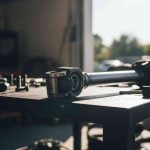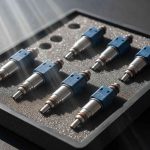Understanding the Complete Bumper Assembly System
When most people think of a car bumper, they picture the visible outer shell that gives their vehicle its sleek appearance. However, a modern vehicle’s bumper assembly is far more sophisticated than this surface-level component. It’s a multi-layered safety system engineered to protect both vehicle occupants and pedestrians during collisions, while also contributing to aerodynamics and fuel efficiency.
Whether you’re shopping at salvage yards near you or planning a DIY repair, understanding what lies beneath that plastic cover can save you money and ensure you get the right parts for your vehicle’s safety systems.
The Multi-Layer Structure of Modern Bumper Assemblies
A complete bumper assembly consists of several distinct layers, each serving a specific purpose in impact management and vehicle protection:
Bumper Cover (Fascia) – The Visible Layer
The bumper cover is what most people recognize as “the bumper.” This outer shell is typically manufactured from flexible plastics like polycarbonate or polypropylene, designed to absorb minor impacts and return to its original shape. Beyond aesthetics, it serves important functions:
- Aerodynamic shaping to reduce drag
- Protection for underlying safety parts
- Integration points for fog lights, sensors, and cameras
- Minor impact absorption from parking lot bumps
Energy Absorber – The Crush Zone
Hidden behind the cover lies the energy absorber, often made of compressible foam, plastic honeycomb, or hydraulic dampeners. This critical safety part is designed to compress and deform during impact, dissipating kinetic energy before it reaches the vehicle’s frame and occupants.
Reinforcement Bar – The Structural Backbone
The reinforcement bar or bumper beam represents the assembly’s structural foundation. Manufactured from high-strength steel or aluminum, this part distributes impact forces across the vehicle’s chassis through reinforced mounting points. It’s essentially part of your vehicle’s safety skeleton.
Brackets and Hardware
Metal brackets secure the entire assembly to the vehicle’s frame, ensuring proper alignment and structural integrity during both normal operation and collision events.
Cosmetic vs. Structural: Understanding the Critical Difference
One of the most important distinctions when evaluating a used bumper assembly is understanding the fundamental difference between cosmetic and structural parts:
| Part | Primary Role | Material | Inspection Priority |
|---|---|---|---|
| Cosmetic Cover | Aesthetics, minor impact absorption, aerodynamics | Plastic (Polycarbonate, PP) | Scratches, warping, large cracks |
| Reinforcement Bar | Structural integrity, major impact distribution | Steel or Aluminum | Bends, cracks, mounting point damage |
While the cover handles minor scrapes and maintains vehicle appearance, the reinforcement bar is the critical safety part that must remain structurally sound. Even if the cover appears undamaged, a compromised reinforcement bar requires replacement, as repairs rarely restore original strength specifications.
Comprehensive Inspection Guide for Used Bumper Assemblies
When sourcing a used bumper assembly from salvage yards, thorough inspection of all layers is essential, as damage may be hidden behind seemingly intact covers.
Inspecting the Plastic Cover (Fascia)
- Visual Assessment: Check for major cracks, tears, or warping affecting structural integrity
- Deformation Detection: Examine from multiple angles in good lighting to spot subtle deformation
- Mounting Tab Integrity: Inspect all mounting tabs and fasteners for cracks or breaks
- Integrated Systems: Verify fog lights, sensors, or cameras haven’t been compromised
Evaluating the Foam Energy Absorber
- Compression Marks: Look for crushing or permanent deformation indicating previous impact
- Hidden Damage Assessment: Never assume integrity based solely on cover condition
Examining the Steel Reinforcement Bar
- Straightness Verification: The bar must be perfectly straight for proper impact distribution
- Crack Detection: Inspect the metal beam for any cracks or tearing
- Attachment Point Analysis: Check mounting points for stress, tears, or deformation
“Any bending or twisting of the reinforcement bar means it cannot distribute impact loads correctly and should be replaced immediately.”
Professional Removal Techniques and Hidden Fastener Locations
Removing a complete bumper assembly requires systematic approach and knowledge of hidden fastener locations that vary by vehicle manufacturer:
Preparation Steps
- Secure vehicle on jack stands for underneath access
- Gather appropriate tools including penetrating oil for rusted fasteners
- Document electrical connections with photos before disconnection
Locating Hidden Bolts in Fender Wells
The most commonly overlooked fasteners are hidden within the fender well areas:
- Pull back plastic wheel well shield/liner from fender area
- Secure shield with clamp or bungee cord for access
- Remove bolts/screws securing bumper sides to fender or frame structure
- Some vehicles feature long screws running vertically from inside wheel wells
Electrical and Final Separation
- Disconnect wiring harnesses for fog lights and parking sensors
- Carefully separate plastic clips without breaking retention tabs
- Remove reinforcement bar bolts from vehicle frame (often underneath)
Cost-Effective Sourcing and Quality Verification
When shopping for used bumper assemblies, understanding market dynamics and quality indicators can significantly impact your purchase decision. Modern data science approaches are revolutionizing how we analyze vehicle part compatibility and pricing trends, similar to how advanced research methodologies are being applied across various industries.
Quality Verification Checklist
- Request impact history from salvage yard staff
- Verify VIN compatibility for proper fitment
- Test integrated electrical systems before purchase
- Examine paint code matching for color consistency
Safety Considerations and Professional Installation
While sourcing used car bumpers can provide significant cost savings, proper installation remains critical for maintaining vehicle safety systems. The integration of modern safety technologies, including collision sensors and pedestrian protection systems, requires precise alignment and calibration.
Professional Installation Benefits
- Proper torque specifications for mounting bolts
- Electrical system integration and testing
- Sensor calibration and alignment verification
- Warranty coverage for installation work
Environmental Impact and Sustainable Auto Repair
Choosing used bumper assemblies supports environmental sustainability by extending part lifecycles and reducing manufacturing demand. This approach aligns with circular economy principles, where materials maintain their highest value for as long as possible.
If your current vehicle has sustained significant damage and bumper replacement costs exceed the vehicle’s value, consider exploring cash for cars options to responsibly recycle your vehicle while obtaining funds for a replacement.
Future Trends in Bumper Assembly Technology
As automotive technology evolves, bumper assemblies are becoming increasingly sophisticated. Advanced driver assistance systems (ADAS), pedestrian detection sensors, and autonomous vehicle technologies are being integrated into these seemingly simple parts. Understanding these trends helps inform purchasing decisions and highlights the importance of comprehensive inspection protocols.
The integration of artificial intelligence and machine learning in automotive safety systems, similar to developments highlighted in emerging technology trends, will continue to influence how bumper assemblies function as part of comprehensive vehicle safety networks.
Making the Right Choice for Your Vehicle
Getting a used bumper assembly represents more than just replacing a damaged cover—it’s about understanding and maintaining a sophisticated safety system. By recognizing the multi-layered structure, conducting thorough inspections, and ensuring proper installation, you can achieve significant cost savings while maintaining vehicle safety standards.
Remember that while the visible bumper cover might seem like the primary concern, the hidden structural parts play the most critical role in protecting vehicle occupants. Take time to inspect all layers, understand the removal process, and consider professional installation for optimal results.
Whether you’re restoring a classic vehicle, repairing collision damage, or upgrading your current car, a complete understanding of bumper assembly systems will help you make informed decisions and ensure long-term satisfaction with your automotive investment.





Leave a Reply
You must be logged in to post a comment.